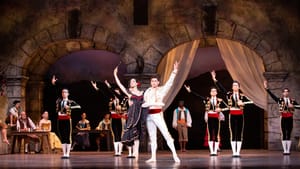Stay in the Loop
BSR publishes on a weekly schedule, with an email newsletter every Wednesday and Thursday morning. There’s no paywall, and subscribing is always free.
Justice for Cervantes
The Pennsylvania Ballet presents ‘Don Quixote’

Miguel de Cervantes was falsely imprisoned, wounded in battle, and captured by Barbary pirates, who kept him for five years as a galley slave. And yet out of this traumatic life, he created one of the most enduring (and endearing) works in literature. In Don Quixote, Cervantes leavened the madness with understanding and tempered the ironic humor with affection, and the Pennsylvania Ballet’s current production does the tale justice.
It is a credit to the book and its interpreters that a ballet by a French choreographer (Marius Petipa) and a Russian composer (Ludwig Minkus) for the imperial courts of tsarist Russia can still capture that wry humor and warmth. As translated for a modern audience in a staging by our own Angel Corella, it does so without sacrificing any of the technical brilliance we expect of a grand ballet.
Kitri and Basilio
The ballet centers on the romance of Kitri, the village beauty, and Basilio, the boy next door who excels at music and flirting but not at making money. It is the anti-Romeo and Juliet: Kitri’s father wants her to marry the wealthy Gamache, but Basilio’s fake-his-own-death trick works this time. Don Quixote defends the young lovers (though he warns Basilio to start thinking about money now that he has a wife). The couple celebrates their wedding with one of the most famous grand pas des deux in the repertoire.
For the audience on opening night, the ballet comes to life from the moment it opens on our intrepid madman, danced by ballet master Charles Askegard, reading romances of chivalry at his desk. With the aid of his Sancho Panza (Ashton Roxander, who gets some of the best slapstick moments in the small role) Don Quixote is off on his quest to find his imaginary Dulcinea.
In the village, Maraya Piniero’s saucy and flirtatious Kitri shakes her red, tiered flamenco skirt and kicks up her heels in a leap so grand that her back leg nearly touches her head. Her dance between the toreadors’ tankards was one of my favorites. Arian Molina Soca’s Basilio flirts with the ladies like a true Romeo, but is soon brought to heel by a fiery Kitri who is having none of that.
Jermel Johnson’s hilarious Gamache, in red velvet with a white ruff and a hat smothered in ostrich feathers, makes a poor suitor. Kitri vanquishes him with her fan. Basilio almost punches his future father-in-law in the nose, but quickly thinks better of it when he sees who the nose belongs to. The arrival of Don Quixote and his semi-competent squire add to the slapstick chaos.

Farce, sizzle, magic, and power
Act 1 is suitably busy for a farce, but Sterling Baca and Lillian DiPiazza rivet our attention in the roles of Espada and Mercedes. Baca, in white, leads the black-clad toreadors in a dance of posturing bravado with swirling capes. The dance ends when Baca skims his cape across the stage. It stops, outstretched, at the feet of his Mercedes, and we can imagine Espada in its place, if he were not so proud. In contrast to Piniero and Molina Soca’s cat-and-mouse dance of courtship, Baca and DiPiazza sizzle when they come together.
Act 2 takes us to the Romani camp outside of town. Nayara Lopes and Zecheng Liang are quite wonderful as the dancers here. Lopes, in particular, dances with a raw abandon so immediate she might have been making it up on the spot. But we have come to the countryside so that Don Quixote can hit his head while tilting at the windmill (a wonderful set piece from a completely different part of the book), and dream the magical portion of the evening, the ballet blanc. Don Quixote imagines Kitri as his fair Dulcinea among the dryads. Piniero’s Dulcinea is cool and remote as a dream, her posture and movement formal and removed from her fierce Kitri.
Don Quixote saves the best for last: the wedding grand pas de deux that comes at the very end of Act 3. But first, DiPiazzo and Baca are back, all braggadocio and seduction. The male dancers as toreadors are wonderful, arms angled to evoke Spanish dance while they drop to one knee, and do it again. The adagio section of the grand pas, with its powerful final lift into a fish dive is justifiably famous, and Piniero and Molina Soca performed it well, but the solos made me smile. While the technique was there throughout, I felt the pairing was still a bit tentative.
Future stagings
In 2016, The Pennsylvania Ballet rented the set for Don Quixote (designed by Ralph Funicello) from the San Diego Opera. When San Diego decided to retire their production, the Pennsylvania Ballet bought it. Corella keeps an eye on the bottom line, but he prefers to maintain his own productions whenever possible. The ballet had already constructed its own costumes, and this move will protect the production for the future.
What, When, Where
Don Quixote. Choreographed by Angel Corella. The Pennsylvania Ballet. Through October 20, 2019 at the Academy of Music, 240 South Broad Street, Philadelphia. (215) 893-1999 or paballet.org.
The Academy of Music is an ADA-compliant venue.
Sign up for our newsletter
All of the week's new articles, all in one place. Sign up for the free weekly BSR newsletters, and don't miss a conversation.

 Camille Bacon-Smith
Camille Bacon-Smith